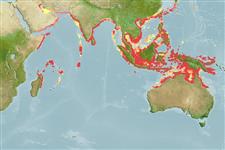Elasmobranchii (haaien en roggen) (sharks and rays) >
Carcharhiniformes (Ground sharks) >
Sphyrnidae (Hammerhead, bonnethead, or scoophead sharks)
Etymology: Eusphyra: eu- (Gr.), good, well or very; sphyra (Gr.), hammer, referring to immense hammer-shaped head. (See ETYFish); blochii: In honor of physician-naturalist Marcus Elieser Bloch (1723-1799), who described and illustrated this shark in 1785, which he identified as Squalus zygaena. (See ETYFish).
More on author: Cuvier.
Issue
Eusphyra laticeps (Cantor, 1837) is a valid species after Fernando et al 2019 (Ref. 120444).
Environment: milieu / climate zone / depth range / distribution range
Ecologie
marien; brak water benthopelagisch; amfidroom (Ref. 51243). Tropical; 31°N - 20°S, 47°E - 154°E
Indo-West Pacific: Persian Gulf to the Philippines, north to China, south to Australia.
Lengte bij maturiteit / Grootte / Gewicht / Leeftijd
Maturity: Lm ?, range 120 - ? cm
Max length : 186 cm TL mannelijk / geslacht onbekend; (Ref. 6871)
Dorsale stekels (totaal) : 0; Anale stekels: 0. Grey or grey-brown above, paler below. Expanded lateral blades of head very narrow and wing-like, with a series of small bumps along edges in front of nostrils; width across head 40 or 50% of total length. Nostrils enormously expanded, each nearly 2 times the mouth head (Ref 13562).
Found in shallow water on continental and insular shelves (Ref. 244). Enters estuaries (Ref. 4832). Feeds mainly on small teleost fishes but also takes crustaceans and cephalopods (Ref. 13562). Viviparous (Ref. 50449), with 6 to 25 pups in a litter (Ref. 6871). Has a remarkable wing-shaped head which is nearly or quite half of its body length, the function of which is uncertain, maybe for maneuvering or for increasing the surface area of some of the sense organs (Ref. 244). Probably harmless to people (Ref. 13562). Caught commonly, but in low numbers, by inshore gillnet fisheries. Particularly common in catches off Kalimantan (Ref.58048). Probably a common fisheries species where it occurs (Ref. 13562). Meat utilized for human consumption; liver is a source of vitamin oil (Ref. 244). Offal probably utilized for fishmeal (Ref. 13562). Reported to reach 300 cm TL (Ref. 58784).
Viviparous, placental (Ref. 50449), with 6 to 25 in a litter after a gestation period of 8 (Ref.58048) -11 months (Ref. 6871). Size at birth between 32 and 45 cm TL (Ref. 13562).
Compagno, L.J.V., 1984. FAO Species Catalogue. Vol. 4. Sharks of the world. An annotated and illustrated catalogue of shark species known to date. Part 2 - Carcharhiniformes. FAO Fish. Synop. 125(4/2):251-655. Rome: FAO. (Ref. 244)
Status op de Rode Lijst van het IUCN (Ref. 130435)
Gebruik door de mens
Visserij: commercieel
Tools
Speciale rapporten
Download XML
Internetbronnen
Estimates based on models
Preferred temperature (Ref.
123201): 25.2 - 29.1, mean 28.3 °C (based on 970 cells).
Fylogenetische diversiteitsindex (Ref.
82804): PD
50 = 1.0010 [Uniqueness, from 0.5 = low to 2.0 = high].
Bayesian length-weight: a=0.00513 (0.00275 - 0.00956), b=3.24 (3.07 - 3.41), in cm total length, based on LWR estimates for this species & (Sub)family-body (Ref.
93245).
Trofisch niveau (Ref.
69278): 4.2 ±0.6 se; based on diet studies.
Weerstandsvermogen (Ref.
120179): Zeer laag, minimale populatieverdubbelingstijd meer dan 14 jaar (Fec=6).
Fishing Vulnerability (Ref.
59153): Very high vulnerability (90 of 100).
Nutrients (Ref.
124155): Calcium = 16.6 [2.7, 88.0] mg/100g; Iron = 0.526 [0.132, 1.586] mg/100g; Protein = 18.9 [16.9, 21.1] %; Omega3 = 0.129 [0.056, 0.295] g/100g; Selenium = 76.7 [22.3, 229.5] μg/100g; VitaminA = 19 [8, 48] μg/100g; Zinc = 0.721 [0.349, 1.352] mg/100g (wet weight);
